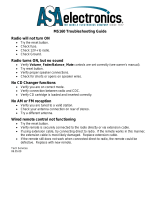
2
Important Safety Precautions
CAUTION: TO REDUCE THE RISK
OF ELECTRIC SHOCK, DO NOT
REMOVE BACK PANEL.NO USER
SERVICEABLE PARTS INSIDE.
REFER SERVICING TO QUALIFIED
SERVICE PERSONNEL.
DANGEROUS VOLTAGE
The lightning ash with arrowhead, within an equilateral
triangle, is intended to alert the user of the presence of non-
insulated “dangerous voltage” within the product’s enclosure
that may be of sucient magnitude to constitute a risk of
electric shock to persons.
ATTENTION
The exclamation point within an equilateral triangle is
intended to alert the user of the presence of important
operating and maintenance (servicing) instructions in the
literature accompanying the apparatus.
FCC Notice:
This device complies with part 15 of the FCC Rules. Operation is subject to the following two conditions: (1) this device may not
cause harmful interference, and (2) this device must accept any interference received, including interference that may cause
undesired operation.
This equipment complies with FCC radiation exposure limits set forth for an uncontrolled environment. This equipment should be
installed and operated with minimum distance 20cm between the radiator and your body.
NOTE 1:
This equipment has been tested and found to comply with the limits for a Class B digital device, pursuant to part 15 of the FCC rules.
These limits are designed to provide reasonable protection against harmful interference in a residential installation. This equipment
generates, uses and can radiate radio frequency energy and, if not installed and used in accordance with the instructions, may
cause harmful interference to radio communications. However there is no guarantee that interference will not occur in a particular
installation. If this equipment does cause harmful interference to radio or television reception, which can be determined by turning
the equipment o and on, the user is encouraged to try to correct the interference by one or more of the following measures:
- Reorient or relocate the receiving antenna
- Increase the separation between the equipment and receiver
- Connect the equipment into an outlet on a circuit dierent from that to which the receiver is connected
- Consult the dealer or an experienced radio / TV technician for help
NOTE 2:
Any changes or modications to this unit not expressly approved by the party responsible for compliance could void the user’s
authority to operate the equipment.
Industry Canada Notice:
This radio transmitter had been approved by Industry Canada. This Class B digital apparatus complies with the Canadian standard
ICES-003. This device complies with Industry Canada License exempt RSS standard(s). Operation is subject to the following two
conditions: (1) this device may not cause interference and (2) this device must accept any interference, including interference that
may cause undesired operation of the device. The device has been evaluated to meet general RF exposure requirement.
• Read these instructions.
• Keep these instructions.
• Heed all warnings.
• Follow all instructions.
• Do not use this apparatus near water.
• Clean only with a dry cloth.
• Do not block any ventilation openings. Install in accordance
with the manufacturer’s instructions.
• Do not install near any heat sources such as radiators, heat
registers, stoves, or other apparatus (including ampliers) that
produce heat.
• Protect the power-supply cord from being walked on or
pinched, particularly at plugs, convenience receptacles and the
point where they exit from the apparatus.
• Only use attachments / accessories specied by the
manufacturer.
• Use only with the cart, stand, tripod, bracket, or table specied
by the manufacturer, or sold with the apparatus. When a
cart is used, use caution when moving the cart / apparatus
combination to avoid injury from tip-over.
• Unplug this apparatus during lightning storms or when
unused for long periods of time.
• Refer all servicing to qualied service personnel. Servicing
is required when the apparatus has been damaged in any
way, such as power-supply cord or plug is damaged, liquid
has been spilled or objects have fallen into the apparatus,
the apparatus has been exposed to rain or moisture, the
apparatus does not operate normally, or the apparatus has
been dropped.
• Apparatus shall be connected to a MAINS socket outlet with a
protective earthing connection.
• An appliance input coupler is used as the disconnect device -
the disconnect device shall remain readily operable.
• Batteries or battery packs shall not be exposed to excessive
heat such as sunshine, re or the like.



















